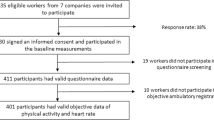Summary
Physical work capacity was measured by means of a symptom limited, near maximal cycle ergometer exercise test in two populations: (a) a random sample of 95 military officers, and (b) 2014 apparently healthy working males, 40–59 years old. Physical activity during leisure hours was assessed by means of a standardized questionnaire and by a personal interview with the officers and with 1769 of the other men. A 3 year total incidence of coronary heart disease (CHD) was recorded in the case of the officers and a 7 year CHD incidence and of CHD deaths was obtained for the 2014 working men.
The data show that: a) A marked underestimation of the habitual levels of physical activity of the officers was obtained from the standardized questionnaire, as compared with that shown by the interview data. b) A far better agreement between the questionnaire and interview data on leisure time activity was observed among the mainly sedentary men. c) Physical work capacity was fairly well predicted from the questionnaire data in the sedentary men, but poorly predicted in the officers. d) CHD mortality in the sedentary men was highly correlated with working capacity in all age groups. Of 58 who died from CHD, 28 belonged to the lowest physical fitness quartile. This study indicates that questionnaires should be used with caution when assessing levels of habitual physical activity. It also suggests that a low physical work capacity is an important risk factor in CHD mortality.
Similar content being viewed by others
References
Aronow WS (1973) 30-month follow-up of maximal treadmill stress test and double Master's test in normal subjects. Circulation 47:287–290
Åstrand PO, Rodahl K (1986) Textbook of work physiology. 3. d. Mc Graw Hill, New York, p 420
Cooper KH, Pollock ML, Martin RP, White SR, Linnerud AC, Jackson A (1976) Physical fitness levels vs selected coronary risk factors. A cross-sectional study. J Am Med Ass 236:166–169
Erikssen J, Rodahl K (1979) Seasonal variation in work performance and heart rate response to exercise. A study of 1835 middle-aged men. Eur J Appl Physiol 42:133–140
Erikssen J, Mundal R (1982) The patient with coronary artery disease without infarction: Can a high-risk group be identified? Ann NY Acad Sci 382:438–449
Erikssen J, Enge I, Forfang K, Storstein O (1976) False positive diagnostic tests and coronary angiographic findings in 105 presumably healthy males. Circulation 54:371–376
Erikssen J, Rasmussen K, Forfang K, Storstein O (1977) Exercise ECG and case history in the diagnosis of latent coronary heart disease among presumably healthy middle-aged men. Eur J Cardiol 5/6:463–476
Erikssen J, Forfang K, Jervell J (1981) Coronary risk factors and physical fitness in healthy middle-aged men. Acta Med Scand [Suppl] 645:57–64
Froelicher VF (1977) Does exercise conditioning delay progression of coronary atherosclerotic heart disease? Cardiovasc Clin 8:11–31
Giagnoni E, Secchi MB, Wu SC, Morabito A, Oltrona L, Mancarella S, Volpin N, Fossa L, Bettazzi L, Arangio G, Sachero A, Folli G (1983) Prognostic value of exercise EKG testing in asymptomatic normotensive subjects. New Eng J Med 309:1085–1089
Karvonen MJ (1967) Questionnaire methods in the assessment of habitual physical activity. In: Karvonen MJ, Barry AJ (eds) Physical activity and the heart. Charles C Thomas Co, Springfield, pp 329–330
Keys A (1970) Coronary heart disease in seven countries. Circulation [Suppl 1] 41
Kuller L, Cooper M, Pepper J (1972) Epidemiology of sudden death. Arch Int Med 129:714–719
Lie H, Erikssen J (1984) Latent coronary heart disease in athletes. A five year follow-up study of 122 long term active cross-country skiers. Acta Med Scand 216:377–383
Mork T (1962) A comparative study of respiratory disease in England, Wales and Norway. Acta Med Scand [Suppl] 172:384
Oberman A (1980) The role of exercise in preventing coronary heart disease. In: Rapaport E (ed) Current controversies in cadiovascular disease. W. B. Saunders Company, Philadelphia, London, Toronto, pp 29–41
Paul O (1980) Exercise and the prevention of coronary artery disease: The evidence is inconclusive. In: Rapaport E (ed) Current controversies in cardiovascular disease. W. B. Saunders Company, Philadelphia, London, Toronto, pp 42–46
Rapaport E (1980) Does exercise prevent coronary artery disease? In: Rapaport E (ed) Current controversies in cardiovascular disease. W. B. Saunders Company, Philadelphia, London, Toronto, p 47
Taylor HL, Jacobs DR, Schucker B, Knudsen J, Leon AS, Debacker G (1978) A questionnaire for the assessment of leisure time physical activities. J Chron Dis 31:741–755
Author information
Authors and Affiliations
Rights and permissions
About this article
Cite this article
Mundal, R., Erikssen, J. & Rodahl, K. Assessment of physical activity by questionnaire and personal interview with particular reference to fitness and coronary mortality. Europ. J. Appl. Physiol. 56, 245–252 (1987). https://doi.org/10.1007/BF00690888
Accepted:
Issue Date:
DOI: https://doi.org/10.1007/BF00690888




